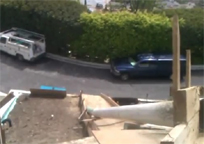Chutes and Ladders

The first two videos in this sequence were about access, and this one is, too – but with a difference. Where the other projects challenged us with tight access, and we had to figure out ways to take care of the excavation spoils on relatively level lots, this one is a case where we were able to take advantage of gravity to get two big jobs done.
It’s very cool that the site was rigged with a funicular that could carry us from the street up 80 feet or so to the terrace where we’d be working, but that was just icing on the cake. What was best about the site from the perspective of demolition and excavation was that we had a clear shot to the bottom of the slope once we installed sturdy chutes made of plywood and framing lumber.
The project still involved lots of hard hand labor, but the tedious, backbreaking effort required to move unwanted material from the job site to the dump trucks was greatly simplified.
Two points: First, you need to consider the degree of the slope and be certain material will stay in the chute. You don’t want to be pelting downslope houses with wayward concrete missiles. Second, you need to keep an eye on the chute itself and watch for damage or weak points as the demolition and excavation processes move forward. Again, it’s a matter of controlling heavy, hurtling material in large volumes, so you need to be certain the structure you’ve built is up to the task.
As I said, the funicular was cool, but the chute was great.
Video: To survey the site, click here.
Randy Beard operates Pure Water Pools, a construction/service firm based in Costa Mesa, Calif. He may be reached at [email protected].










